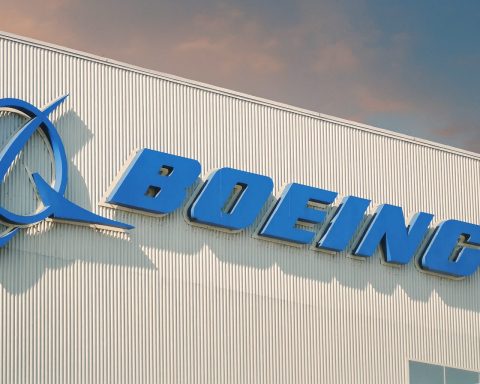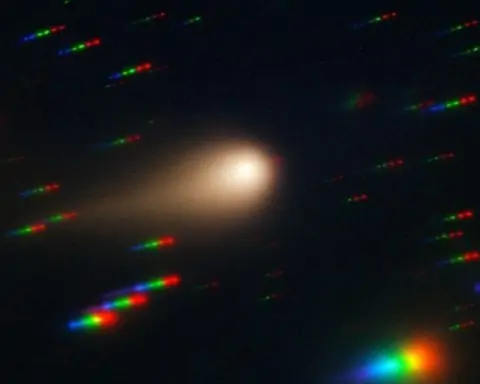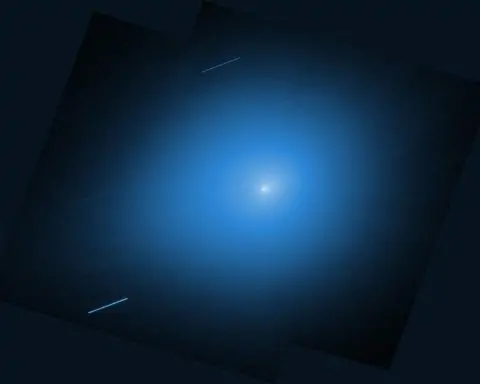- Vulcan Centaur debuted on its first national security mission, USSF-106, launching from Cape Canaveral on August 12, 2025 at 8:56 p.m. EDT and is powered by two BE-4 engines while carrying the NTS-3 satellite.
- The USSF-106 mission deployed the Navigation Technology Satellite-3 (NTS-3) and marks the Defense Department’s shift to flying critical military satellites on domestic rockets powered by U.S.-made engines.
- Ariane 6 mission VA264 delivered MetOp-SG A1 to a 800 km polar sun-synchronous orbit after a 2:37 a.m. CEST launch from Kourou on August 13.
- MetOp-SG A1 is Europe’s next-generation polar-orbiting weather satellite, built by Airbus for ESA/EUMETSAT and hosting the new Sentinel-5 instrument alongside six advanced sensors.
- SpaceX launched 24 Starlink satellites on August 14 from Vandenberg and planned to launch 28 more from Florida, continuing near-daily cadence for the Starlink constellation.
- China launched the eighth batch of Guowang satellites on August 13 with a Long March 5B from Wenchang, the fourth Guowang mission in under three weeks, with each flight carrying 8–10 large satellites toward a planned ~13,000-satellite network.
- Amazon’s Project Kuiper reached 102 satellites after an August 11 Falcon 9 launch from Cape Canaveral delivering 24 Kuiper satellites, as it pursues a planned 3,200-satellite network.
- NASA’s Artemis II Orion spacecraft was fully fueled and moved to the Launch Abort System Facility on August 10, with the crew of four—Reid Wiseman, Victor Glover, Christina Koch, and Jeremy Hansen—aiming for an early-2026 crewed lunar mission.
- Webb observations of TRAPPIST-1d indicate the Earth-sized planet, about 40 light-years away, lacks an Earth-like atmosphere, with no thick CO2 or O2 detected.
- Hubble Space Telescope observations announced on August 13 revealed an ultra-massive white dwarf formed from the merger of two stars, challenging previous assumptions about white dwarf masses.
ULA’s Vulcan Centaur Debuts on National Security Mission
A major rocket milestone unfolded as United Launch Alliance’s Vulcan Centaur successfully launched its first national security mission on August 12, 2025 [1]. Lifting off from Cape Canaveral at 8:56 p.m. EDT, the methane-fueled Vulcan carried the USSF-106 payload – an experimental Navigation Technology Satellite-3 (NTS-3) – directly into geosynchronous orbit [2]. This marks the U.S. Defense Department’s formal shift to flying critical military satellites exclusively on domestic rockets powered by U.S.-made engines [3], ending reliance on older foreign-supplied boosters. The mission was a full success, deploying the first new U.S. navigation satellite in decades. “This is a game-changing capability,” said L3Harris engineer Andrew Builta, noting NTS-3’s advanced anti-jamming technologies and reprogrammable software aimed at countering growing threats to GPS [4] [5]. Vulcan’s flawless debut for national security payloads – powered by two BE-4 engines from Blue Origin – heralds a new era of modernized U.S. launch vehicles supporting defense needs [6].
Europe’s Ariane 6 Delivers Next-Gen Weather Satellite
Just hours later in French Guiana, Europe’s new Ariane 6 rocket notched a success of its own. In the early hours of Aug. 13, an Ariane 6 blasted off (mission VA264) carrying EUMETSAT’s MetOp-SG A1 weather satellite [7]. The 2:37 a.m. CEST launch from Kourou inserted MetOp-SG A1 into a polar sun-synchronous orbit about 800 km up [8]. This is the third launch of Ariane 6 (and second commercial flight), a pivotal heavy-lift vehicle designed to secure Europe’s independent access to space [9] [10]. MetOp-SG A1 is the first of Europe’s next-generation polar-orbiting weather satellites, built by Airbus for ESA/EUMETSAT, and it also hosts the new Sentinel-5 atmospheric monitoring instrument for the EU’s Copernicus program [11]. With six advanced sensors aboard, the satellite will deliver higher-resolution data on climate and weather – tracking everything from temperature and precipitation to pollution and sea ice – taking Europe’s Earth observation capabilities “to a new level” [12]. The successful Ariane 6 launch is a relief for Europe after delays, and it underscores a renewed focus on environmental monitoring, while demonstrating Ariane 6’s readiness for operational service [13].
Satellite Mega-Constellations: Starlink, Guowang, and Kuiper Expand
SpaceX and China continue their neck-and-neck deployment of broadband internet constellations. On August 14, a SpaceX Falcon 9 from California’s Vandenberg base lofted 24 more Starlink satellites into low Earth orbit [14]. Hours later, another Falcon 9 was slated to launch 28 Starlinks from Florida, as SpaceX maintains an aggressive cadence aiming at near-daily launches. These two missions – part of the thousands-strong Starlink network – highlight SpaceX’s drumbeat of expansion to improve its global satellite internet coverage. Meanwhile, China’s answer to Starlink, “Guowang”, achieved a major push on Aug. 13. A Long March 5B rocket thundered into orbit from Wenchang at 2:43 p.m. local time, carrying the eighth batch of Guowang broadband satellites [15]. The launch was China’s fourth Guowang mission in under three weeks [16] – an unprecedented pace. Each Long March 5B flight carries only 8–10 large satellites (versus 20+ on a Falcon 9) due to their size [17]. Even so, “China is ramping up construction of its national satellite-internet megaconstellation”, with Guowang planned to reach ~13,000 satellites [18]. The Guowang constellation (meaning “national network”) is run by state-owned China SatNet and aims to rival Starlink in providing global internet [19]. Chinese officials hailed the latest launch as a complete success [20], underlining Beijing’s resolve to accelerate its presence in the burgeoning space internet sector.
Not to be outdone, Amazon’s Project Kuiper also hit a milestone. On August 11, SpaceX launched 24 Kuiper satellites on a Falcon 9 from Cape Canaveral, bringing Amazon’s fledgling broadband constellation to 102 satellites in orbit [21]. This was Amazon’s fourth deployment in just four months (following launches in April, June, and July) as it races to populate a planned 3,200-satellite network. The Kuiper KF-02 mission’s success means Amazon has now surpassed 100 satellites deployed for its high-speed internet system [22]. The Kuiper craft will raise themselves to 630 km orbits over coming months [23]. With Starlink, Guowang, and Kuiper all accelerating, the global race for satellite internet dominance is in full swing, promising enhanced connectivity even in remote areas – while also raising concerns about orbital crowding and competition [24] [25].
NASA’s Artemis 2 Moonship Fueled and Ready for Launch Prep
On the human spaceflight front, NASA’s Artemis II mission took a key step toward the Moon. NASA announced that the Orion spacecraft for Artemis 2 has now been fully fueled with propellants and oxidizer, clearing another milestone on its road to launch [26]. On Aug. 10, teams at Kennedy Space Center moved the fueled Orion capsule from the processing facility to the Launch Abort System Facility, where it will be mated with its emergency escape tower [27]. This major processing milestone signifies that Orion is “all fueled up and going through final preparations” ahead of being stacked atop the Space Launch System (SLS) mega-rocket [28]. Artemis 2 – currently targeting a launch in early 2026 – will carry a crew of four (NASA astronauts Reid Wiseman, Victor Glover, Christina Koch, and CSA astronaut Jeremy Hansen) on a 10-day journey around the Moon and back [29]. It will be the first crewed voyage beyond low Earth orbit since Apollo, testing Orion’s life support systems in deep space. NASA reports that the Artemis 2 Orion has passed its fueling, pressure tests, and even a “suited” test with the crew inside [30]. Now engineers are installing the 13-meter Launch Abort System atop Orion – a safety tower with powerful thrusters designed to whisk the crew capsule away from the SLS rocket if needed [31]. With Orion nearly flight-ready, NASA’s return to the Moon is drawing closer, even as schedules remain cautious. (Artemis 2 is officially No Earlier Than February 2026 [32].) The milestone reflects steady progress despite recent budget and workforce cuts at NASA – underscoring the agency’s commitment to “move the needle” on human exploration of the Moon.
Breakthroughs in Space Science and Exploration
It’s been a banner couple of days for cosmic discoveries. Using the James Webb Space Telescope, astronomers revealed new insights about a promising exoplanet. TRAPPIST-1 d, an Earth-sized world orbiting a red dwarf 40 light-years away, appears to lack any Earth-like atmosphere [33]. Webb’s precise measurements showed no signs of a thick carbon dioxide or oxygen-rich air blanket on TRAPPIST-1 d, ruling out an atmosphere similar to Earth’s or Venus’ [34]. This finding, published Aug. 13, narrows the planet’s habitability prospects – if TRAPPIST-1 d is bare and airless, it’s likely inhospitable despite lying in its star’s habitable zone. The result demonstrates Webb’s remarkable capability to probe the atmospheres of distant rocky planets, a key step in the search for life beyond our solar system. “It does not have an Earth-like atmosphere,” the research team concluded, dashing hopes that this ultra-cool star’s third planet might be a living world [35].
Astronomers also reported what may be an unprecedented type of stellar explosion. In a study augmented by artificial intelligence, scientists observed a massive star exploding while interacting with a black hole companion – potentially the first recorded case of a star’s supernova being triggered by a black hole’s influence [36] [37]. The event, SN 2023zkd, was detected last year by an automated sky survey, and AI algorithms flagged its unusual properties in real time [38]. Follow-up telescopes saw the supernova inexplicably brighten again months after the initial blast. Analysis of archival data revealed the star had exhibited strange outbursts for years before exploding, likely due to extreme gravitational stress from an orbiting black hole [39]. “2023zkd shows some of the clearest signs we’ve seen of a massive star interacting with a companion in the years before explosion,” said Ashley Villar, an astronomer at Harvard and co-author of the study. “We think this might be part of a whole class of hidden explosions that AI will help us discover.” [40] The team posits two scenarios: the black hole’s gravity destabilized the star until it went supernova, or the black hole might even have directly ripped the star apart, with the debris producing the explosion’s light [41] [42]. Either way, the aftermath would leave a single heavier black hole. This rare observation – made possible by intelligent algorithms catching the phenomenon early – could open a new window on star-death physics, revealing how binary interactions can lead to “odd” explosions outside of traditional supernova models [43] [44].
In other astronomical news, the Hubble Space Telescope uncovered a stellar rarity: an ultra-massive white dwarf that formed from the merger of two smaller stars. Announced on Aug. 13, this finding came from Hubble’s ultraviolet observations and suggests that such double-star merger remnants may be more common than thought [45]. The merged white dwarf is significantly larger than a typical single-star white dwarf, tipping the scales at a mass that challenges previous assumptions [46]. Discoveries like this inform scientists about the late stages of stellar evolution and how unusual cosmic specimens form. Meanwhile on Mars, NASA’s Perseverance rover stumbled upon a fun visual oddity: a rock shaped strikingly like a medieval helmet [47]. The rover’s cameras snapped images of the helmet-shaped stone on the Red Planet’s surface, adding to a growing gallery of Mars’ weirdly shaped rocks carved by wind and erosion. While just a quirky coincidence of geology, the find sparked public intrigue and highlights Perseverance’s ongoing exploration of Jezero Crater’s ancient river delta [48]. And in astrobiology, a new study suggested that liquid water may not be the only elixir of life – exotic solvents like liquid methane or ammonia could potentially support alien life, expanding the scope of what “habitable” means beyond Earth [49]. All told, the past two days have delivered a wealth of scientific insight, from exoplanet atmospheres to explosive cosmic events, keeping researchers busy rewriting textbooks.
Space Policy and Defense Updates
In policy news, the U.S. Space Force rolled out its proposed 2026 budget, seeking $11 billion in funding [50]. The hefty request – a notable increase from prior years – is earmarked for new satellite constellations, improved launch infrastructure, and enhanced space-based defense capabilities. Pentagon officials argue the boost is needed to maintain U.S. technological advantages in orbit, but some experts are asking whether this growth is sustainable long-term [51]. Analysts caution that beyond the headline figure, how the money is allocated will determine its impact on programs [52]. The budget reveal has kicked off debate in Washington about balancing ambitious space initiatives with fiscal realities – all while global rivals ramp up their military space investments.
At the same time, the Space Force’s procurement arm, the Space Development Agency (SDA), inked a major contract extension with industry. General Dynamics was awarded $491 million to continue developing and managing SDA’s satellite ground control systems [53]. This extension more than doubles the funding for General Dynamics’ role in SDA’s “Proliferated Warfighter Space Architecture,” a planned network of hundreds of LEO satellites for communications, missile tracking, and targeting. The contract will support a “tranche-agnostic” ground segment, meaning it can operate satellites across multiple future batches of SDA spacecraft [54]. The award underscores the Pentagon’s commitment to resilient, next-gen space infrastructure – leveraging commercial players to build out the command-and-control backbone for swarms of military satellites.
Internationally, space diplomacy saw progress. In late July, Senegal became the 56th country to sign the NASA-led Artemis Accords, pledging to adhere to principles of peaceful, transparent exploration [55]. Senegal’s signing – the fourth African nation to join – was hailed as another step toward broad global norms for activities like lunar exploration and resource use [56] [57]. The Artemis Accords, grounded in the 1967 Outer Space Treaty, have now drawn a diverse roster of nations from every continent, reflecting a growing consensus on responsible behavior beyond Earth. This expansion of the Accords comes as NASA and partners prepare for the Artemis lunar missions, and it emphasizes international cooperation even amid a competitive space race. Observers note that bringing developing space nations like Senegal into the fold helps ensure inclusive participation in humanity’s return to the Moon and beyond [58] [59].
Commercial Spaceflight Highlights
The private space sector also made headlines alongside government programs. Blue Origin achieved a celebratory suborbital flight on Aug. 3, launching its 34th New Shepard mission (NS-34) with six passengers. Liftoff from West Texas occurred at 8:43 a.m. ET, sending the crew briefly above the Kármán line for a few minutes of weightlessness [60]. Among the riders was Justin Sun, a cryptocurrency billionaire finally taking his delayed ticket to space, joined by adventurers from multiple countries [61] [62]. “It was an honor to see so many nations represented on our flight today. The view of our fragile planet from space has a unifying effect on all who witness it,” said Phil Joyce, Blue Origin’s Senior VP for New Shepard, highlighting the diverse international makeup of the crew [63]. This space tourism flight underscores the continued demand for suborbital trips – NS-34 was Blue Origin’s 14th human spaceflight to date, and the company has now flown over 30 civilians in its bid to “democratize” access to space.
Rocket Lab also notched a win, further solidifying its role in small launch. The California/New Zealand-based company successfully conducted its 11th Electron launch of 2025, deploying a synthetic-aperture radar satellite for Japan’s iQPS on August 5. Codenamed “The Harvest Goddess Thrives,” the mission was Rocket Lab’s 69th Electron flight overall [64]. Notably, Rocket Lab maintains a 100% success rate this year, even as it increases cadence – a testament to operational maturity after some past setbacks [65]. The company is simultaneously preparing its next big leap: the medium-lift Neutron rocket, slated for a debut test flight later in 2025 [66]. Neutron is designed to be reusable and could challenge SpaceX’s Falcon 9 in the small-to-medium payload class. Rocket Lab’s steady drumbeat of launches (and expansion to a new pad in Wallops Island, Virginia) shows that smaller launch providers are thriving, meeting demand for dedicated rides to orbit for commercial and government smallsats.
Not all private launch ventures are prospering, however. ABL Space Systems, a startup developing the RS1 rocket, announced significant layoffs and a strategic pivot in early August [67]. The move came after a second launch attempt ended in a pad explosion last month, destroying the vehicle. Following that failure, ABL’s founders decided to step back from the crowded commercial launch market and refocus on defense-related projects [68]. The company’s CEO stated the layoffs – affecting a large portion of staff – were needed to conserve cash and “make the company more efficient”, possibly hinting at work on missile defense targets or suborbital systems instead of orbital launch [69] [70]. ABL’s retrenchment underscores the challenges facing newer rocket startups in an increasingly competitive field dominated by incumbents like SpaceX and emerging alternatives like Rocket Lab and Relativity. Venture funding for launch has tightened, and only those with unique niches or deep-pocket backers are likely to survive the shakeout.
Expert Commentary: As space activities surge worldwide, experts note an inflection point akin to a new Space Age. “We’re seeing a real acceleration – from mega-constellations changing the economics of space, to new rockets coming online, to unprecedented scientific discoveries,” said a space policy analyst. The past 48 hours alone illustrate the breadth: national agencies, commercial players, and scientists are all driving bold advances. International cooperation (like the Artemis Accords) is expanding even as geopolitical competition intensifies in orbit. With more launches, satellites, and ambitious missions on the horizon, the period of August 13–14, 2025, will be remembered as a snapshot of a rapidly evolving space landscape – one marked by innovation, collaboration, and a dash of rivalry among the stars.
Sources: Key information has been drawn from official announcements and trusted news outlets including SpaceNews, Space.com, and agency press releases. For detailed coverage of each story, see the cited sources [71] [72] [73] [74] [75] [76] [77] [78] [79] [80], among others. Each development represents a significant step in humanity’s journey into space during this eventful mid-August span.
References
1. keeptrack.space, 2. www.space.com, 3. keeptrack.space, 4. www.space.com, 5. www.space.com, 6. keeptrack.space, 7. newsroom.arianespace.com, 8. newsroom.arianespace.com, 9. newsroom.arianespace.com, 10. newsroom.arianespace.com, 11. newsroom.arianespace.com, 12. newsroom.arianespace.com, 13. newsroom.arianespace.com, 14. www.space.com, 15. www.space.com, 16. www.space.com, 17. www.space.com, 18. www.space.com, 19. www.space.com, 20. www.space.com, 21. www.aboutamazon.com, 22. www.aboutamazon.com, 23. www.aboutamazon.com, 24. www.space.com, 25. www.space.com, 26. www.space.com, 27. www.space.com, 28. www.space.com, 29. www.space.com, 30. www.space.com, 31. www.space.com, 32. www.space.com, 33. esawebb.org, 34. esawebb.org, 35. esawebb.org, 36. www.space.com, 37. www.space.com, 38. www.space.com, 39. www.space.com, 40. www.space.com, 41. www.space.com, 42. www.space.com, 43. www.space.com, 44. www.space.com, 45. esahubble.org, 46. esahubble.org, 47. www.space.com, 48. www.space.com, 49. www.space.com, 50. keeptrack.space, 51. keeptrack.space, 52. keeptrack.space, 53. spacenews.com, 54. spacenews.com, 55. www.space.com, 56. www.space.com, 57. www.space.com, 58. www.space.com, 59. www.space.com, 60. www.space.com, 61. www.space.com, 62. www.space.com, 63. www.space.com, 64. www.stocktitan.net, 65. www.stocktitan.net, 66. www.stocktitan.net, 67. payloadspace.com, 68. payloadspace.com, 69. payloadspace.com, 70. payloadspace.com, 71. keeptrack.space, 72. www.space.com, 73. newsroom.arianespace.com, 74. www.space.com, 75. www.space.com, 76. esawebb.org, 77. www.space.com, 78. esahubble.org, 79. www.space.com, 80. www.space.com










